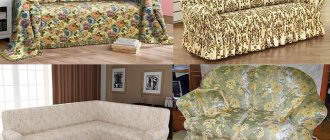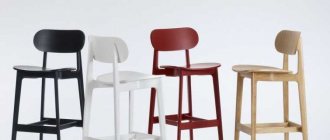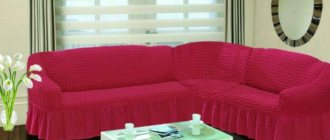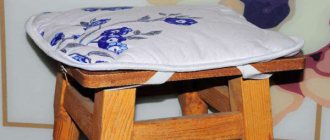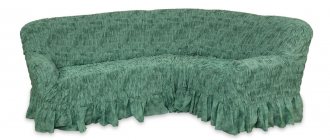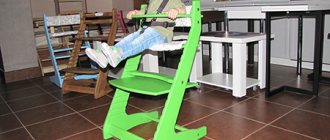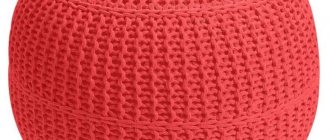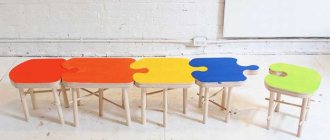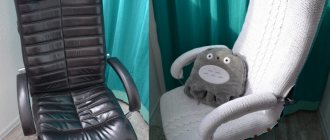Share on social media networks:
Has the old fabric cover on your baby high chair become unusable? Your budget doesn't allow for a new one, so why spend money on a new baby chair if your baby is comfortable and safe in the old one? Don’t rush to get upset - there is always a way out. We advise you to try to sew such a case with your own hands, saving a decent amount of money that can be spent on other needs of the child. To update the surface, you only need to purchase suitable fabric and insulation, and all other tools can be found at home. Today we will share several ways on how to sew a cover for a high chair with your own hands.
Why do you need a cover for a highchair?
A baby chair cover is an indispensable item for both mother and child. Many mothers do not understand what functions the cover on a children's chair performs. This is a very important point to pay attention to. We will try to help you with this difficult issue.
A baby's high chair is needed for the following reasons:
- In order to grow quickly, a child should eat well. Often, when feeding, the baby gets dirty himself and the objects around him. Therefore, in order to reduce cleaning time, a highchair was created that can be washed or wiped with a damp cloth at any time. Its cleaning depends on the material it is made of.
- It will be uncomfortable for a child to sit in a high chair that does not have a cover. Sitting on a hard surface is extremely uncomfortable, so the baby will constantly move, be capricious, and as a result may completely refuse to use this type of furniture. The comfort of a highchair determines the mood, health and appetite of your child.
- The cover increases the safety of the child and protects him from possible impacts and falls. Many manufacturers equip highchairs with seat belts so that the mother can leave the baby for a while without worrying that something might happen to him during her absence.
As you can see, the cover for a children's high chair plays a very important role in your child's life, so we recommend that you pay special attention to the sewing technique.
Beautiful examples of cases
To expand the reader's creative potential, below are options for beautiful and elegant slipcovers that can restore any furniture to its former glory.
A colorful throwaway fabric can easily change the look of a simple bar stool.
Thus, the pattern for chair covers is not particularly complicated. Anyone, even a novice craftswoman, can do this and other stages of work. There are many classes of styles of covers; they are divided into formal and everyday. Based on this, the material for production, the presence of decorative elements and other things are selected.
How to sew a cover for a children's high chair with your own hands?
Before sewing a cover, you need to think about what you want the future product to look like. The most comfortable option is considered to be feeding covers that can be placed on the upper and lower parts of the back of the chair using a special pocket. It is desirable that their design be supplemented with seat belts to protect the child from various injuries. For cleaning and washing, the entire cover should be quickly and easily removed.
Preparing for cutting
To make the case comfortable enough, try to use 2 layers of fabric:
- For the top layer, natural soft fabric or oilcloth with edging is suitable - it all depends on how you want to clean the product.
- The inner layer is made of foam rubber or padding polyester, which makes the baby's seat as comfortable as possible.
For work, prepare the following materials and tools:
- Durable cotton fabric.
- Sintepon for the inner layer.
- Scissors.
- Chalk or soap.
- Tailor's pins.
- Threads.
- Needle.
- Paper or non-woven fabric for creating a pattern.
- A simple pencil.
- Centimeter.
- Sewing machine.
Pattern
To quickly sew a cover for a high chair with your own hands, make an old pattern for sewing a new one. This is done as follows:
- Carefully remove the old cover from the baby chair.
- Straighten all its parts and lay them out on a flat surface.
- Attach paper or non-woven fabric to the cut, draw its contours with a pencil. This way we will get a pattern for the future cover.
- Mark the places of the previous lines on the pattern and apply markings for the holes for the seat belts. To do this, you need to place the pattern of the cover on the children's chair, and then lay the pattern on top. We measure on the pattern the places of the slots and bends of the seat.
Cutting and sewing
When the pattern is ready, you can start sewing the cover:
- We cut out pockets and lining, for which we will use cotton fabric. Large pockets allow you to cover the backrest, armrests and seat area of your highchair. To do this, using a template, cut out 4 parts: two sides, the top and bottom of the cover.
Important! Don’t forget to make a seam allowance of 1 cm from the contour of the pattern on the pattern.
- After cutting the pockets, we bend their lower part several times and stitch them with a machine. Place the pockets on the right side of the top fabric and sew everything together using a sewing machine.
- With the wrong side we place the top layer of fabric with pockets on the padding polyester, pin the structure together, sweep it over and cut it out. After these steps, we sew all the details along the entire perimeter of the cover. We leave a small hole at the bottom of the product so that the cover can be turned outward.
- We turn the cover inside out so that the seal remains under the cotton fabric.
- We baste according to the previously made marks, and then attach the lines on the sewing machine.
Additional actions
There is very little left to get a new cover for a children's highchair:
- Now we need to seal the hole with which we turned the product inside out. The best way is to close it with a hidden seam. If you don’t know how to do it, then sew up the hole in any way. As a result, you should get a neat and discreet seam.
- Sew the elastic on the wrong side of the baby's seat.
- We cut the previously marked holes for the seat belts, process them with a looped seam, and pass the child restraints through them.
Additional actions
The cover for the high chair is almost ready. The next step is to remove the hole through which the product was turned inside out. It is best to seal it with a hidden seam, but if you are not an experienced seamstress and do not know how to do this, you can sew up the hole in any way you know. The main thing is that the seam is neat and not conspicuous.
On the underside of the seat of the resulting cover, you can sew a wide elastic band, with which the product will be secured to the chair. If your child is still quite small, it is advisable to equip the cover with seat belts. To do this, cut holes in the marked places, sew them with a buttonhole stitch and pass belts through them that will securely hold your baby during feeding.
Related article: Cracks in the furnace: putty solutions
It is worth saying that without sufficient experience it is quite difficult to sew a product such as a cover for a high chair, so it is necessary to pay the utmost attention to the process. The finished cover will delight you and your child with its convenience for a long time. And no one will argue: a happy child means a happy mother!
The best posts
- How to make a plasterboard ceiling in the kitchen with your own hands
- Painting drywall - step-by-step instructions
- How to join drywall in corners and the process of building a decorative niche
- Sealing drywall joints - recommendations from professionals
- Epoxy resin, application
- How to seal a doorway with plasterboard - installation diagram
- DIY plasterboard ceiling installation - video tutorials and installation instructions
- How and how to glue a foam plastic ceiling plinth
We sew a cover for a children's high chair with our own hands - a step-by-step master class
This method is suitable for those who had a chair made of raincoat fabric. Torn oilcloth fabric can injure the baby - scratch, cause allergic irritations on the skin. Therefore, we advise you not to hesitate in replacing the cover for your highchair. If you have decided on choosing such a fabric, then we suggest that you familiarize yourself with the step-by-step instructions for sewing a raincoat fabric cover.
Let's take for work:
- Raincoat.
- Fabric of choice.
- Threads.
- Kant.
- An elastic band.
- Chalk.
- Tracing paper or polyethylene.
- Felt pen.
- Sintepon.
Algorithm of actions:
- We start by choosing fabric. It all depends on your preferences. In this case, we will use raincoat fabric - it is durable, wear-resistant and easy to clean. But it may happen that the child will find it uncomfortable to sit, since such material often sticks and is cold to the touch. We recommend using softer fabrics - corduroy, velvet or flannel. Such a cover will be comfortable, but it will be difficult to care for. An alternative can be crepe, which is not as durable as raincoat fabric, but is pleasant to the body, easy to wash and does not wrinkle at all.
- We begin to make a pattern for the future cover. For these purposes, you can use the old cover or, if it is badly damaged, cut out a cover from oilcloth. To do this, take a suitable piece of oilcloth and place it on top of the chair, press it well, forming all the reliefs of the old cover. We outline with a felt-tip pen all the parts and details of the chair where the future cover will be fixed. We cut out the oilcloth sample, place it on the chair again and check the similarity of the arrangement of the parts.
- Now take the required amount of fabric and fold it in half. We put on the old cover from the high chair and begin to transfer the contours to the fabric. After this, we cut out the pattern, taking into account seam allowances and padding polyester.
- We perform the same manipulations with padding polyester. It must be cut strictly along the pattern lines, without adding additional allowances.
- Using the scheme described above, we make a pattern for the rear (1 piece) and side (two pieces on each side) fixation of the cover.
- We cut out holes for the straps on the back and on the seat of the chair, and then sew it with a zigzag seam or overlock.
- We put the padding polyester under the fabric layer of the cover and grind it down, leaving a small hole for further turning the product inside out.
- Now you need to turn the entire product right side out through the small cutout left.
- Sew up the hole with a blind stitch.
- We sew the entire structure, taking into account the visible lines on the front side.
That's it, the new highchair cover for your baby is ready for new challenges!
Benefits of making your own chair covers
Firstly, the covers, which were created by hand, not only meet all the style preferences of the hostess, but are also made conscientiously, from high-quality material. Chairs with backrests and stools in protective covers do not lose any of their practical properties, but acquire new characteristics: beauty, elegance. Removable upholstery protects furniture from premature aging and abrasion.
Simple cover for kitchen chairs
During the sewing process, you can determine how well a particular fabric is suitable for the seat, how it sits and stays on it. It is impossible to check this when purchasing store products.
Important! If the cover is sewn by hand, it will be of high quality and will cost a minimum of money or almost free if fabrics from old things were used for sewing.
Homemade stool covers
The advantages of making “upholstery” with your own hands are obvious:
- The seats will be original and will fit perfectly into the interior of the room if certain requirements are met;
- Furniture that has been improved through “cladding” will become more comfortable and will “live” longer due to its protection;
- Manufacturing will take little material and money, and the appearance of the furniture will change dramatically;
- Removable covers can be easily removed and washed if they get dirty.
Covers not only protect furniture, but also complement the interior
An easy way to sew a cover
Now we will share the fastest and easiest way to sew such a necessary product.
Let's take the following materials and tools:
- 2 square-shaped pieces of foam rubber (size depends on the back and seat of the chair).
- 1 piece of any very thick fabric of your choice.
- Bias tape.
- Narrow satin ribbon.
- Threads to match the fabric.
- Needle.
- Scissors.
- Sewing machine.
Let's get started:
- Now we need to measure the length of the baby’s seat in the high chair: the back and the seat. After this, add 15 cm to the bottom and top of the cover - this will serve as pockets for putting on a chair. The end result should be one solid piece.
- We retreat 15 cm from the top and bottom edges of the fabric and fold the fabric along the line. After this, we make a seam on the side, forming a pocket for the cover on the chair.
- We process the edges of the fabric with tape along the entire perimeter of the cover.
- Now we need to make ties to secure the cover to the chair. To do this, take a satin ribbon and cut it into 6 equal sections 10 cm long. We bend and stitch the edges of the strips or process them with an overlocker.
- We attach or manually sew the ties to the cover so that 2 of them secure the back, 2 - the side parts, and the rest - the seat of the high chair.
- To get your baby started using the high chair, place the cut out foam on the seat and back of the high chair.
- Place the sewn cover on top and tie all the ties to a bow.
This beautiful case is ready to do its job!
Video material
Now you are convinced that it is not necessary to buy a new cover for a children's high chair. It is much more pleasant to sew such a product with your own hands, since your soul and warmest feelings will be invested in it. We wish your little one a great appetite and good mood!
